Blog Category Tutorials
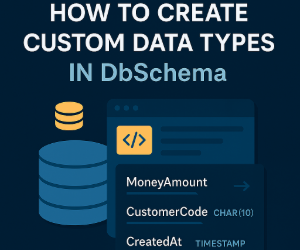
How to Create Custom Data Types in DbSchema
Create custom data types in DbSchema’s Logical Design to standardize columns; on deployment they convert to native DBMS types like VARCHAR.
Tutorials • 17-Sep-2025

SQL UPDATE Statement Explained with Examples
The UPDATE statement in SQL is used to modify the data of an existing record in a database table. We can update single or multiple columns. Is part of DML.
Tutorials • 23-Aug-2025
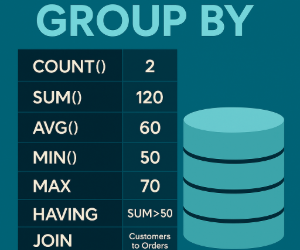
SQL GROUP BY Explained with Examples
Learn how to use SQL GROUP BY with clear examples. Understand SUM, COUNT, AVG, and HAVING step by step. Beginner-friendly and easy to follow.
Tutorials • 21-Aug-2025
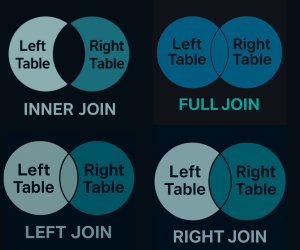
SQL Joins Explained - INNER, LEFT, RIGHT, FULL
Understand SQL JOINs with clear examples. Learn how INNER JOIN, LEFT JOIN, RIGHT JOIN, and FULL JOIN work and when to use each. Beginner-friendly.
Tutorials • 08-Aug-2025
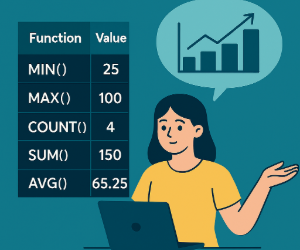
What Are Aggregate Functions in SQL? Learn with Examples
Learn SQL aggregation functions like SUM, COUNT, and AVG with simple examples. Understand how they work and generate them visually in DbSchema.
Tutorials • 07-Aug-2025
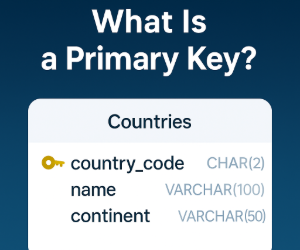
What Is a Primary Key in SQL? Learn with Examples
A primary key is a column in a database table that uniquely identifies each row. Each table can have only ONE primary key, and it can’t be left empty.
Tutorials • 06-Aug-2025
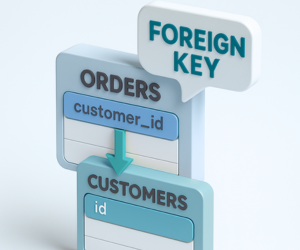
What Is a Foreign Key Constraint in SQL?
A foreign key links one table to another by matching values, usually to a primary key. It keeps data accurate and prevents invalid references.
Tutorials • 31-Jul-2025

SQL NULL Functions Explained with Examples
In this tutorial, you are going to learn about the SQL NULL Functions.
Tutorials • 15-Oct-2023

SQL CASE Expression Explained with Examples
In this tutorial, you are going to learn about the SQL Case Expression.
Tutorials • 13-Oct-2023

SQL INSERT INTO SELECT Statement Explained
In this tutorial, you are going to learn about the SQL INSERT INTO SELECT Statement.
Tutorials • 12-Oct-2023

SQL SELECT INTO STATEMENT Explained with Examples
In this tutorial, you are going to learn about the SQL SELECT INTO Statement.
Tutorials • 11-Oct-2023

SQL ANY AND ALL OPERATORS Explained with Examples
In this tutorial, you are going to learn about the SQL ANY and ALL Operator.
Tutorials • 10-Oct-2023

SQL EXISTS Operator Explained with Examples
In this tutorial, you are going to learn about the SQL Exists Operator.
Tutorials • 09-Oct-2023

SQL HAVING Clause Explained with Examples
In this tutorial, you are going to learn about the SQL Having Clause.
Tutorials • 08-Oct-2023

SQL INTERSECT Operator Explained with Examples
In this tutorial, you are going to learn about the SQL INTERSECT OPERATOR.
Tutorials • 10-Sep-2023

SQL GROUP BY Statement Explained with Examples
In this tutorial, you are going to learn about the SQL GROUP BY STATEMENT.
Tutorials • 10-Sep-2023

SQL UNION Operator Explained with Examples
In this tutorial, you are going to learn about the SQL UNION OPERATOR.
Tutorials • 09-Sep-2023

SQL ALIASES Explained with Examples
In this tutorial, you are going to learn about the SQL ALIASES.
Tutorials • 09-Sep-2023

SQL IN Operator Explained with Examples
In this tutorial, you are going to learn about the SQL IN OPERATOR.
Tutorials • 08-Sep-2023

SQL BETWEEN Operator Explained with Examples
In this tutorial, you are going to learn about the SQL BETWEEN OPERATOR.
Tutorials • 08-Sep-2023

SQL Wildcard Characters Explained with Examples
In this tutorial, you are going to learn about the SQL Wildcard Characters.
Tutorials • 07-Sep-2023

SQL LIKE Operator Explained with Examples
In this tutorial, you are going to learn about the SQL LIKE Operator.
Tutorials • 27-Aug-2023

SQL COUNT(), AVG() and SUM() Functions Explained
In this tutorial, you are going to learn about the SQL COUNT(), AVG() and SUM() Functions.
Tutorials • 26-Aug-2023

SQL MIN() MAX() Functions Explained with Examples
The SQL MIN() and MAX() functions return the smallest and largest values from a column. This guide includes syntax, use cases, and example queries.
Tutorials • 25-Aug-2023

SQL TOP, LIMIT, FETCH FIRST, and ROWNUM Clauses
In this tutorial, you are going to learn about the SQL TOP,LIMIT,FETCH FIRST and ROWNUM Clauses.
Tutorials • 25-Aug-2023

SQL DELETE Statement Explained with Examples
Learn how to use the SQL DELETE statement safely and efficiently. Follow examples and test queries directly in the DbSchema SQL Editor. Try it now!
Tutorials • 24-Aug-2023

SQL NULL Values Explained with Examples
In this tutorial, you are going to learn about the SQL NULL Values.
Tutorials • 22-Aug-2023

SQL INSERT INTO Statement Explained
In this tutorial, you are going to learn about SQL INSERT INTO Statement.
Tutorials • 23-Jul-2023

SQL ORDER BY Keyword Tutorial
In this tutorial, you are going to learn about SQL ORDER BY Keyword.
Tutorials • 22-Jul-2023

SQL AND, OR, NOT Operators Explained with Examples
In this tutorial, you are going to learn about SQL AND,OR and NOT Operators.
Tutorials • 22-Jul-2023

SQL WHERE Clause Explained with Examples
In this tutorial, you are going to learn about the SQL WHERE Clause.
Tutorials • 21-Jul-2023

SQL SELECT DISTINCT Statement Explained
In this tutorial, you are going to learn about the SQL Select Distinct Statement.
Tutorials • 20-Jul-2023

SQL Tutorial with Examples
In this tutorial, you are going to learn about the SQL and Database.
Tutorials • 19-Jul-2023

SQL Syntax Explained with Examples
Learn SQL syntax and basic commands in this tutorial. Understand SQL fundamentals to improve your database skills and start writing queries.
Tutorials • 19-Jul-2023

SQL SELECT Statement Explained with Examples
In this tutorial, you are going to learn about the SQL Select Statement.
Tutorials • 19-Jul-2023

SQL Tables Explained with Examples
In this article, you are going to learn what is table, how to create, modify, delete.
Tutorials • 11-Jul-2023